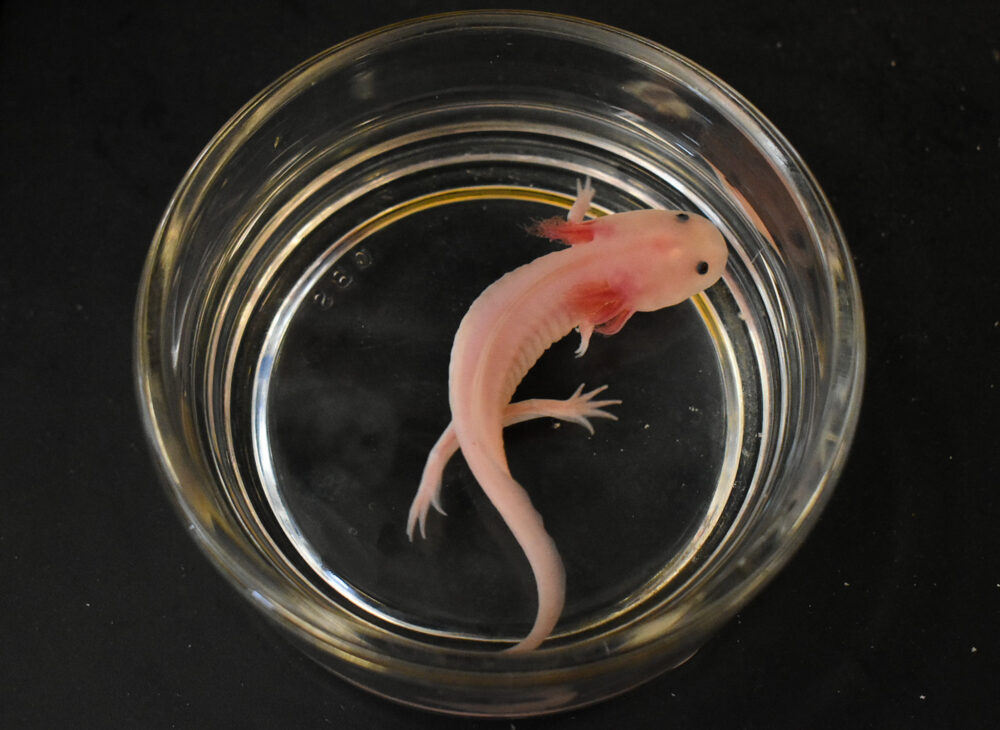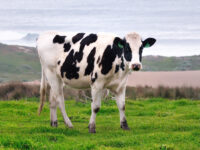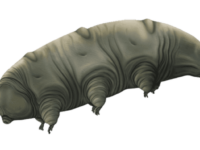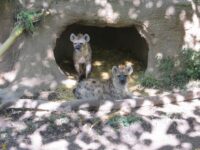One look at an axolotl is enough to explain how such an animal entranced pet owners and scientists alike. Native to the Xochimilco Lake near Mexico City, these salamanders are recognized by their crown-like gills, slight smiles, and uniquely adorable appearances. The axolotl is currently endangered in the wild; however, enthusiasts breed the animal in captivity to live as exotic pets.
This salamander species captivates scientists, and not because of its unique physique. According to studies at the Broad Institute, axolotls have one of the largest and most complex genomes of all living creatures, containing a whopping 32 billion base pairs compared to the 2 billion base pairs in the human genome. They also stand out from other salamanders because of their uncanny ability to regenerate body parts, including their liver, spinal cord, and brain tissue. The magic does not stop there — understanding genetic and molecular mechanisms underlying this healing process can translate to new and efficient treatments for human illnesses and injuries as well.
Axolotls have one of the largest and most complex genomes of all living creatures, containing a whopping 32 billion base pairs compared to the 2 billion base pairs in the human genome.
Before jumping into the applications of regeneration, it is important to understand the process itself. The axolotl first loses tissue, usually a limb, to kick-start regeneration. A thin layer of skin known as the wound epithelium quickly covers the open injury, and the damaged space is innervated. The wound epithelium then communicates with budding nerves to form a signaling center, where signals cause surrounding tissues to de-specialize and form a blastema, or group of cells that take the shape and function of damaged tissue. Therefore, if an injury does not kill them, they can grow the affected area back.
Axolotl regeneration is significantly different from the way mammals heal. Rather than growing an arm or leg back within a couple of weeks, mammals experience fibrosis, which is when scar tissue replaces cells at the original site of injury. This form of healing is faster and more protective in the short term. However, in many cases, the original tissue types do not replace scar tissue and function cannot be fully restored. Understanding regeneration by identifying genes, pathways, and molecules involved in regeneration can improve healing for all mammals, including humans.
Northeastern’s Monaghan Lab is dedicated to decoding regeneration. In 2018, the lab confirmed that axolotls can, in fact, regenerate injured lung tissue. Researchers cut off one-third of axolotls’ lungs and compared genetic and molecular changes to uninjured axolotls. ErbB2 and ErbB4 mRNA was upregulated when the lung was injured, meaning that the resulting receptors are likely involved in lung regeneration. Inhibiting ErbB2:ErbB4 receptors causes the lung to heal up to four times slower than in axolotls with functioning receptors. The Neuregulin-1β (NGR1) molecule, which binds to ErbB2:ErbB4, also plays a significant role in regenerating lung tissue. Injecting NGR1 doubled lung proliferation in uninjured axolotls, while inhibiting the molecule in injured axolotls prevented regeneration and stunted cell development throughout the body. The molecule was therefore hypothesized to be highly involved in cell growth throughout the whole axolotl.
Understanding regeneration by identifying genes, pathways, and molecules involved in regeneration can improve healing for all mammals, including humans.
The Monaghan Lab found that lung regeneration does not occur like limb regeneration. Instead of forming a lung shaped like the uninjured lungs, lung tissue grew back in different sizes and shapes, only restoring function. The entire lung is also involved in regenerating tissue, called compensatory regeneration, whereas limb regeneration only happens at the blastema during epimorphic regeneration.
Although researchers stress the need for mammalian studies, this is a step forward in regenerating human lung tissue. The ErbB2:ErbB4 receptor is found in humans, and increased NGR1 levels cause lung cell proliferation in human lung cells in vitro. Humans are also capable of compensatory regeneration, a feat widely studied in the liver.
The Monaghan Lab’s research does not stop there. Currently, researchers are looking at different factors that could impact regeneration, including nerve dependency, hyper transcription of a variety of genes in regeneration, and retinal regeneration in axolotls. Labs beyond Northeastern’s are also researching regeneration to mitigate aging diseases, apply epigenetics, and understand the chemical impact on regeneration. Humans will not live forever or regrow limbs anytime soon; however, more research into this peculiar salamander may turn life-altering diseases and injuries into routine doctor’s appointments sooner than we think.
Developmental Dynamics (2021). DOI: 10.1002/dvdy.294
Gerontology (2019). DOI: 10.1159/000504294
Trends in Genetics (2017). DOI: 10.1016/j.tig.2017.05.006
The International Journal of Developmental Biology (2021). DOI: 10.1387/ijdb.200276cs
Regeneration (2015). DOI: 10.1002/reg2.32





